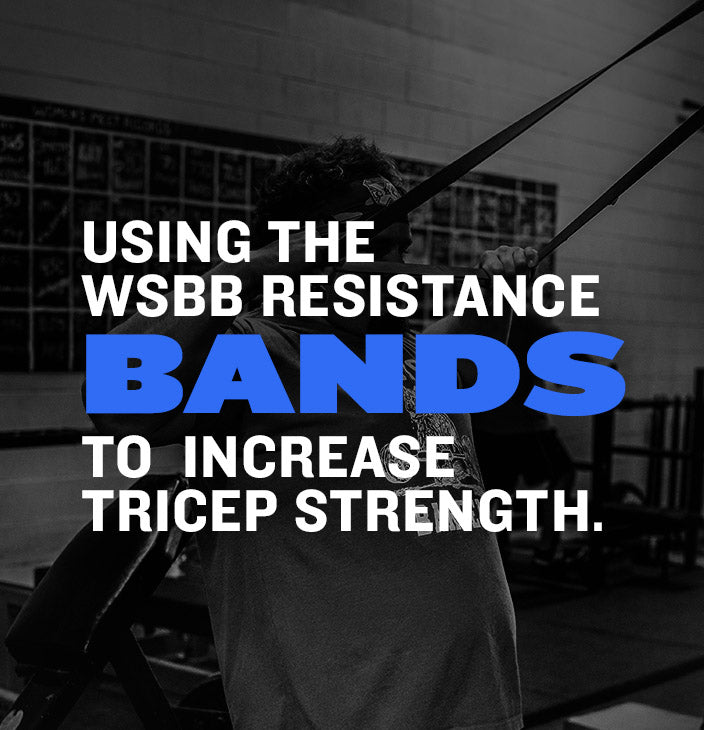WSBB Blog: Getting The Most Out of Your Bands - Triceps

Building a strong upper body requires focusing specifically on developing key muscle groups responsible for performing sport-specific movements. Having strong arms is essential to the upper body strength puzzle, with the triceps being the most prominent arm muscle. Lou realized long ago if you want to develop strong arms and world-class pressing power, you must focus much of your upper body training on tricep development.
Westside Barbell has created some of the strongest benchers in the world, both in gear and raw. Throughout the gym's history, we have had members benching between 700lbs-900lbs regularly in gear, with one lifter benching 1000lbs in a full powerlifting meet on the way to a world record total. It's safe to say when it comes to building bench press strength, Westside Barbell knows the way.
One of the most critical aspects of our bench press programming has been the use of resistance bands. The training effect provided by band training is beneficial to the triceps, considering the way the bands impact the lift. Bands allow a lifter to experience less resistance off of the chest during a bench press, with resistance increasing throughout the range of motion as the lifter presses the barbell.
The effect of the band tension on the barbell causes the triceps to exert and maintain a powerful contraction for a prolonged period compared to a conventional bench press, leading to substantial increases in tricep strength and power. At Westside, we have a few band-focused tricep exercises we use regularly. Add a few of these exercises into your upper body programming, and watch your bench press and overhead press numbers increase.
Bench Press vs. Average Bands
This exercise is not intended for beginners; this is a high-intensity bench exercise that will significantly benefit the lifter looking to go from a 400lb bench to a 500lb bench or more. Pressing against average bands has been a long-standing max-effort variation at Westside Barbell, and it will quickly separate the weak from the strong.
Setting this exercise up is simple. Attach the band to the barbell by halving the band around the bench or squat rack frame, with each loop going around the barbell. If you cannot attach bands to a bench press or squat rack frame, you can build a base to attach to by wrapping the bands around dumbbells heavy enough to anchor the band to the ground.
We will typically work up to max effort singles with this exercise, given the intensity and risk of injury due to the heavy band tension. Multiple rep sets should be avoided as they increase the likelihood of injury.
Dumbbell Press vs. Minibands
One of the best ways to improve the tricep training effect of the dumbbell press, dumbbell press vs. minibands. To set this exercise up, you will first need to wrap the band around your torso correctly. Once you have the band properly set up, you will grab the band on each end like handles with the band wrapped around the torso.
Now that the band is properly wrapped around the torso and in hand, you will then grab the dumbbells. The dumbbell weight should always be the heaviest weight you can lift for the prescribed sets and reps while maintaining optimal form. The rest of the movement is simple; you will perform dumbbell presses with the added band tension applied.
Variations of this exercise include dumbbell floor presses, incline presses, and hammer presses. When performing this exercise, we recommend 3-5 sets of 12-15 reps. The band tension can increase fatigue levels from set to set, so you may have to decrease dumbbell weight to meet set and repetition requirements as the workout carries on.
Floor Press vs. Quad Minibands
Although intense, this workout is generally safe for all lifters as long as appropriate spotting is provided. The floor press vs. quad minibands is one of the best ways to develop absolute bench press and tricep strength.
Proper execution of this exercise is critical. As far as feet placement goes, an athlete can either lay their legs and feet out flat or plant their feet on the ground and elevate their knees like a bench press. When floor pressing with feet on the ground, it is important to avoid raising the pelvis, as this is considered a way to "cheat" the lift.
Start the lift by lowering the weight down in a controlled manner, focusing on keeping the weight on the triceps as much as possible to protect the anterior shoulder and pec muscles. The most important part is to ensure that the triceps lay parallel with the floor before the press is initiated and completed.
Works Sourced:
Westside Barbell Book of Methods; by Louie Simmons
Special Strengths Development for All Sports; by Louie Simmons
Science and Practice of Strength Training; by Dr. Vladimir Zatsiorsky and Dr. William Kraemer




